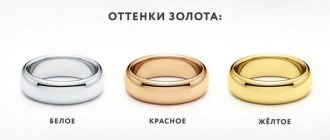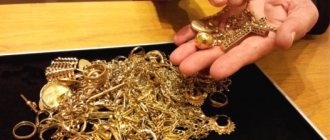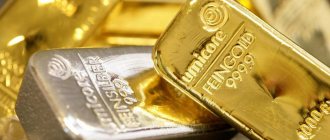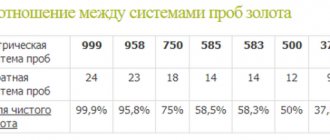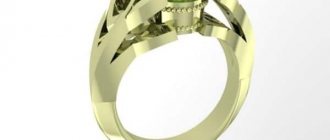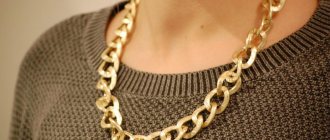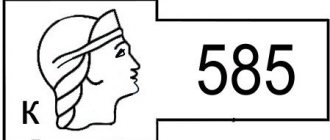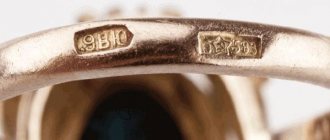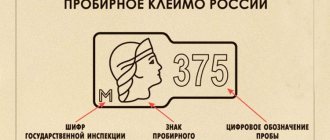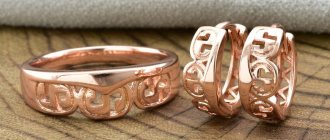Sample 583 as an echo from the USSR, the history of its appearance, its features and composition
From the very beginning of its existence, the USSR adhered to its own policy. The country strived for independence and isolation from the rest of the world, which was evident even when creating jewelry.
Gold jewelry.
Jewelry works of the USSR The whole world used the carat system to determine precious alloys. The USSR followed its own path, introducing the metric measurement system.
Throughout the world, pure gold was equivalent to 24 carats. The value of the alloy used to create jewelry was equal to the number 14 in the carat system. In the USSR, 14 was divided by 24, and the result was multiplied by 1000. The resulting non-integer result was rounded, resulting in the number 583.
This is how a real Soviet-era brand was formed - 583 alloy. The percentage of pure material from the total mass of precious metals was 58, but sometimes a slight plus error was observed. 33% was copper, the remaining 8% was silver.
Main differences
When converted to the carat system, fineness 583 is equal to 14 carats . But since it is impossible to achieve an exact value for the amount of precious metal in the alloy, a deviation from the standard value, or remedium, was introduced equal to 3. Ultimately, fluctuations in the percentage composition of gold in the 583 alloy ranged from 58 to 58.6% . In other words, items of 583 purity could contain only 58% gold (instead of the declared 58.3%). Apparently, this is why the Western market was extremely reluctant to purchase metal of this brand. It did not meet European standards, as a result of which it was purchased at a reduced price.
To avoid financial losses, sample 583 was replaced with 585, increasing the precious metal content in the alloy structure to 58.5%.
Ring 585
Turkish gold and the introduction of GOST standards for testing
In the 80-90s, imported 585 standard began to appear on Soviet shelves. It was massively imported into the country from Turkey. Citizens of the USSR immediately began to buy the wonder; yellow Turkish gold was very different from red Soviet gold.
The jewelry from Turkey was of disgusting quality; the composition contained gold foil. The jewelry became deformed, turned black, and broke.
What was happening caused a wave of indignation on the part of Soviet citizens. The Turkish 585 marking disappeared from the stores, and in its place the display cases were again filled with 583 gold of the highest category.
They stopped producing this alloy only in 1995, when the country had to adopt new GOST standards.
Gold hallmark systems
In the world there are metric, carat and spool systems for gold hallmarks. The most popular are carat and metric, of which the second is most often used. According to the British carat system, which is used in the USA, Switzerland and a number of other countries, a carat is equal to 1/24 of the mass of the entire alloy. Thus, 24 carat gold is a pure substance without additives, but 18 carat means 18 parts of gold in the total proportion of the mixture of metals. In the jewelry industry, you can most often find samples: 9, 10, 14, 18 and 24.
In Russia, since 1711, a spool sampling system has been in use for silver alloys, and in 1733 it was introduced for gold. This measure was invented on the basis of the Russian pound, which contains 96 spools, and the standard itself was expressed by the weight of gold in 96 alloy units. Pure gold had a 96 hallmark, and at the end of the 19th - early 20th centuries, the 56th, 72nd, 82nd, 92nd and 94th hallmarks were in use.
In 1927, the USSR switched to the metric calculation system; all manufactured products that previously had a spool marking changed it to metric. The new system was identical to the German one, and the sample number ranged from 0 to 1000 and demonstrated the presence of gold in the alloy.
Today, many countries use metric quality standards (the most accurate system). In them, the highest standard is the 1000th, but in fact it is not found, and the mark on gold can be a number up to 999.9.
In connection with the problem of calculation errors in the glory of gold, a so-called remedium is established, in other words, a deviation from the norm. In compounds of silver and gold, gold and copper, and all three components together, the remedium is usually set to 3 units. For example, a 583-carat alloy should have a remedium of 3 units, therefore, the gold content will be approximately 580-586 g/1 kg of alloy. Gold alloys with an admixture of nickel have a remedium of 5 units.
In Russia, jewelry for sale can have hallmarks from 375 to 958. The Union also had gold of the 583rd standard, but in Europe there was a standard of 14 carats, which had indicators higher than the Soviet one. To avoid a lower price for our gold in Europe, the standard was changed to 585.
In the modern Russian system, 23-karat gold corresponds to the 958th hallmark, 18-karat gold to the 750th, and so on. To convert from metric to carat, you need to multiply the sample by 0.024.
Gold for export. Reasons for switching to 585 sample
The USSR collapsed, the Iron Curtain collapsed completely, and it became necessary for the country to enter the European market.
The world refused to accept the “USSR brand” as an equal. A snag arose - when converted to the carat valuation system, the value of the 583 sample was 13.9 carats, instead of the proper 14. For Soviet products, they offered a lower price than for similar ones, but corresponding to world standards.
There was a need to introduce a new standard, the country switched to the well-known alloy 585.
The famous Soviet standard - 583 gold
Is it possible to buy 583 samples today?
Many lovers of luxury jewelry today remain faithful to the gold of Soviet times, persistently searching for old items for their collections. Sometimes antique stores offer for sale similar jewelry made of gold marked 583, but their price can be many times higher than the cost of modern products, despite the minimal difference in the percentage of 583 gold from 585.
Secrets of choice
When planning the purchase of an expensive product, you should take into account some features of the choice. Do not think that only the hallmark is the key to quality for many years. When choosing, experts advise adhering to the following rules:
- You can safely purchase simple-shaped jewelry from gold of any standard, focusing on your financial capabilities and taste.
- When buying chains, rings and bracelets containing openwork elements and various weaves, it is better to give preference to metals with the following purity: from 585 to 375. Such alloys are endowed with high strength due to the admixtures of non-ferrous metals, which allows the products not to be afraid of deformation and maintain their original appearance for a long time. many years of wear.
The debate about which sample is better: 583 or 585 has not ceased over the past decades. Nostalgic Russians are sure that only the gold of Soviet times can be considered real. However, experts say that the difference between these alloys is so insignificant that it can easily be neglected.
Modern products with the 585 mark are in no way inferior to the “old” ones either in strength or quality of wear. Manufacturing technology makes it possible to give them not only a fashionable yellow or white color, but also to create alloys of a traditional red hue.
The main differences between samples 583 and 585
Many people believe that when switching to a global model, the “advice brand” only changed the numbers in the name of the sample, but in fact there is a difference.
It is these differences that contribute to the fact that buyers give preference to one or another alloy.
The ratio of precious metal and impurities
The first difference is the gold content. The 583 sample contains 0.2-0.4% less of this noble metal than the generally accepted 585 sample. The discrepancy may be quite insignificant, but it exists. The remaining 33.5% is allocated to copper, 8% to silver, there is no difference here.
Precious metals and impurities
Gold tone
The 583 alloy is more characterized by a red tint. The precious metal was used for minting coins, so the resulting money was often called “chervonets”.
Works with a mark of 585 are often yellow.
But deviations are normal for both alloys, with shades of 14 different colors found.
Type of mark
Initially, mark 583 depicted, in addition to numbers, a male profile and a hammer. Later, the print was changed, and an image of a star, sickle and hammer appeared, which were firmly associated with the USSR.
The modern hallmark for 585 gold looks like an imprint of a woman looking to the left.
Soviet gold - ring with stone
Alloy purity errors
Although both precious metals are equal to 14 karats, each is subject to slight individual uncertainty regarding the presence of pure gold. For 583 alloys, an error of 3% in both directions is considered normal. For 585, the deviation from the purity volume norm can only be in the positive direction - up to 5%.
Advantages and disadvantages
583 gold standard and its advantages:
- Products made from gold metal are quite elastic and wear-resistant.
- Less oxidized compared to other samples.
- Alloy jewelry retains its attractive appearance for a long time.
Yellow metal with a designation of 583 units has no disadvantages. The main problem is that it is currently not possible to purchase this copy in stores. Soviet gold grade 583 lost its demand when grade 585 appeared. It is difficult to say which is better, since the difference of 0.2% is insignificant.
Interesting: Samples of gold metal in the USSR had the symbolism of a sickle and a star. Modern products are stamped 585 and depict a girl in a kokoshnik.
Where can you find 583 gold?
Works using such an alloy are a real rarity in the showcases of modern jewelry outlets. You should try your luck with the search in private workshops, antique shops, pawn shops, and online auctions.
Sometimes such products are found at thematic exhibitions dedicated to the life of Soviet people.
Buying jewelry at a pawnshop
Soviet gold - the standard of quality: myth or truth
Everyone knows that the USSR placed emphasis on quality and long-term service in production. Numerous reviews of products from those times confirm this rule. Jewelry created from the Soviet 583 alloy was truly distinguished by its resistance to various types of damage, reliability, and wear resistance.
Many people still have earrings, rings, and bracelets from those times at home. You can see that the years have not affected the appearance of the products. They will look like new if they are cleaned of natural deposits.
All products of the USSR were produced in compliance with GOST and the strictest technological rules. Low quality was considered unacceptable.
Gold ring with the hallmark 750
The party never spared precious metals for production. This is especially noticeable when you compare standard wedding rings from that era to those of today.
A ring made by craftsmen from the USSR era will be much thicker and heavier.
It is worth agreeing that the characteristics of 583 samples were somehow superior to modern analogues. Under the USSR, this alloy had a reputation as the most reliable, but it still cannot be called a standard of quality.
Caring for 583 and 585 gold
Gold alloys tend to darken due to impurities in their composition. Contact with human skin, different temperatures, and other negative external factors also contributes to changes in appearance.
The best way to care for any precious item is to periodically visit a jewelry workshop. Our experts can clean and polish your jewelry, giving it a shiny new shine.
You can care for gold at home in the following ways:
- You need to place the decoration in a mug containing a soap solution and 4 drops of ammonia for 25-30 minutes. Next, the product will need to be rinsed with running water and wiped dry.
- A similar method, but in a container you will need to mix water with 2 tablespoons of salt. The decoration can be left for half a day.
- For the third method, you will need ceramic dishes, food foil and soda. Cover the bottom of the container with foil, dissolve 2 tablespoons of soda in a mug of water, and pour the liquid into the container. Place the product in the resulting mixture, leave for half a day, and then wipe dry.
Important! Avoid contact of 583 and 585 gold with alkaline reagents. Be sure to remove rings before cleaning or use rubber gloves. Household chemicals often contain aggressive substances.
Composition of Soviet gold
583 gold is often called pure gold, this is due to the color of the metal, namely its reddish tint. The chervonets had a similar ebb. There were also other shades of metal: greenish, pinkish and whitish.
The 583 sample testified to the ratio of the elements that made up the precious metal. Pure gold was always 58%, copper was 33%, and silver was 8%.
The percentage of elements other than the main one could vary and change. This was necessary to achieve the desired shade. For example, if white gold was required, then silver was completely excluded from the alloy, and 16% copper, 17% nickel and 9% zinc were added. If we exclude the last two components, then gold could have pink and green shades.
You may be interested in: Due to what factors and why does the skin turn black from gold?
At the same time, the price of precious metal from various alloys was approximately the same. Many found this alloy an interesting subject for experimentation to achieve unusual color shades.
